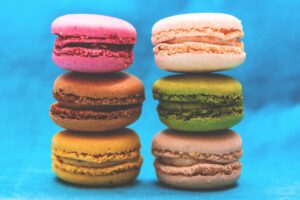From the seemingly innocent to the definitely ominous, additives are everywhere. Even if you cook or bake everything you consume from scratch, you’re still adding substances to food that aren’t naturally found in the raw ingredients. And even if you buy products marked “organic” or “all natural,” they are likely to have added preservatives such as tocopherols (vitamin E) or citric acid–found in fruits such as lemons and oranges, and now produced industrially.
We add subtances to food that aren’t naturally found in the raw ingredients. And even if you buy products marked “organic” or “all natural,” they are likely to have added preservatives such as tocopherols (vitamin E) or citric acid–found in fruits such as lemons and oranges, and now produced industrially.
Additives serve many purposes:
- Colours that enhance appearance
- Preservatives that help protect against food deterioration caused by bacteria.
- Antioxidants that slow down or stop the oxidative deterioration of foods–what we call rancidity
- Artificial sweeteners which are lower in calories than sugar–and cheaper to use.
- Flavour enhancers that improve the taste and aroma of food.
- Presentation and texture enhancers e.g. thickeners, gelling agents, emulsifiers, emulsifiers.
- Nutrient additions that increase the nutrient value of foods
The history of food additives is as old as civilization. Salt, sugar and vinegar were the first preservatives commonly used by cultures around the world, as well as techniques such as smoking and drying. Chemicals have been developed to accelerate or mimic these processes, or as cheaper alternatives to traditional methods.
Although the chemical additives commonly used in foods must be demonstrated to be safe for human consumption, there are still many concerns about their use:
Allergic Reactions
- Sulphite and sulphur dioxide (E220-28) have been known to cause allergic reactions. Specifically, asthma sufferers should avoid sulphur dioxide gas due to increased sensitivity, but there are also recorded cases of worsening of asthma after drinking soft drinks containing it. They are mainly found in dried fruits, dessicated coconut, relishes and fruit-based pie fillings.
- Food colours like tartrazine (E102)can cause mild allergic reactions and some studies show that sunset yellow (E1 10) can cause tumours.
- Annatto, a natural food colouring found in margarine, cheese, smoked fish and cakes is implicated in allergic reactions and irritable bowel.
Cancer
- Aspartame (E951) has been linked to various cancers(1,2,3), although studies by US National Cancer Institute and European Food Safety Authority concluded that it did not increase the risk of cancers.
- Erythrosine is a red food colour. Research has highlighted concerns about its potentialtumour formation and inhibition of the normal functioning of the thyroid.
- Allura red has been associated with cancer in mice but evidence is not consistent.
- Nitrites and nitrates (E249-52) may convert in the stomach to potentially carcinogenic nitrosamines.
Hyperactivity
- Although a definitive link has not yet been established food colours like sunset yellow (E110), quinoline yellow (E104), carmoisine (E122), allura red (E129), tartrazine (E102) and ponceau 4R (E124) have been associated with hyperactivity in some children. These are commonly found in a variety of processed foods, especially in children’s sweets, confectionary, squashes, soft drinks, jams and cakes. Prevalence of hyperactivity is estimated to be about 2.5%.
- Aspartame has also been linked with changes in behaviour.
Headaches
- MSG (monosodium glutamate- E621) is a flavour enhancer can cause headaches in some people. Although in a recent review there was no conclusive direct evidence.
- Aspartame is also linked with causing headaches.
Other
- Gums (E412, E414) are used to thicken food and improve texture. Theycan give rise to flatulence and abdominal pain.
The Bottom Line
Additives are overused in the processed foods industry, so try to avoid them as much as possible.
- Always read food labels to be fully aware of what you are buying.
- Keep processed foods to a minimum, including sweeteners, sweets, lollies, soft drinks and cakes.
- Be careful of foods that are presented as low-fat, sugar-free as they are likely to be additive-rich and nutrient-poor.
- Every individual reacts differently to food and additives. It’s possible to be allergic to anything–even the most “natural” subtance. If you suspect a sensitivity to anything you eat, try a process of elimination to discover the source of the problem, or consult a practitioner trained in nutrition.
- If your child shows signs of hyperactivity of attention deficit hyperactivity disorder (ADHD) then eliminating some colours from their diet may prove beneficial.
If you have concerns about your own diet or that of a family member, and how it may be affecting health, consider scheduling a consultation with us.

